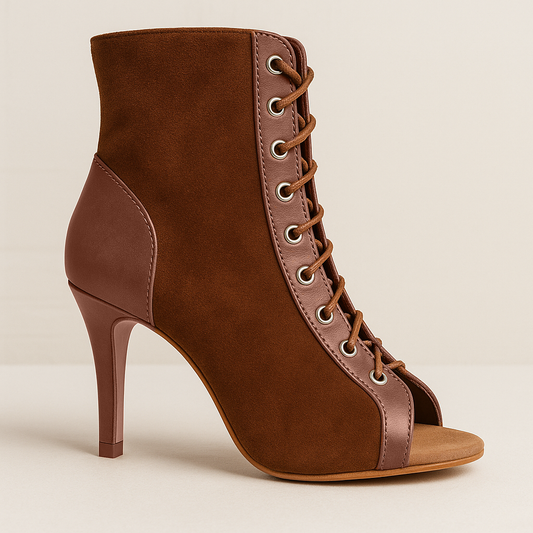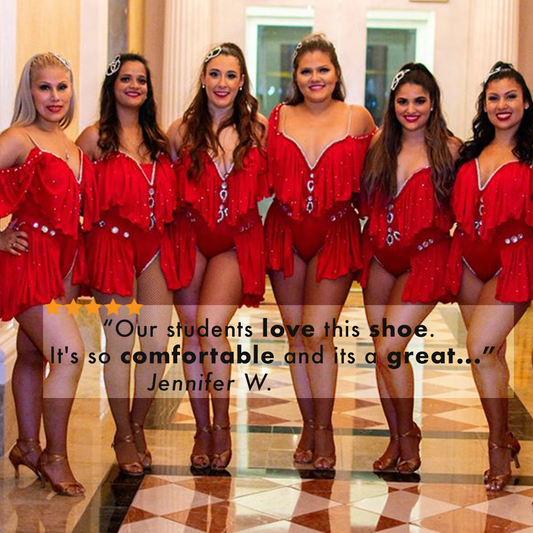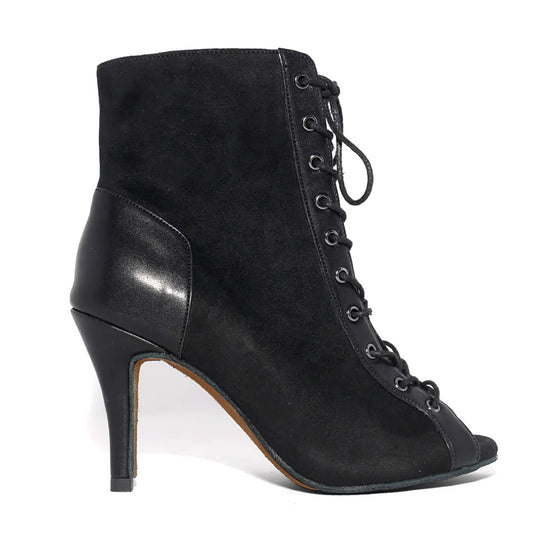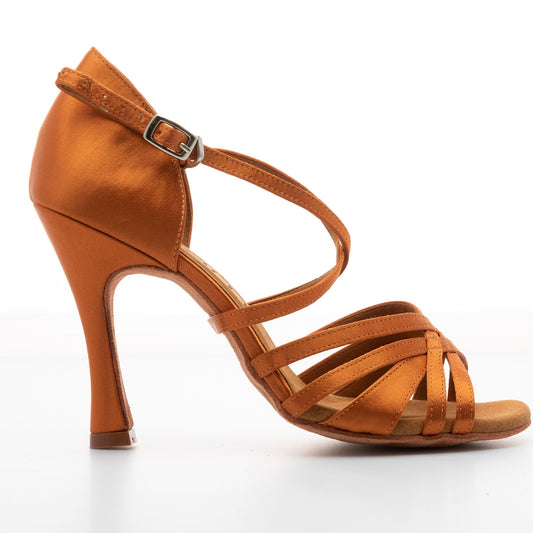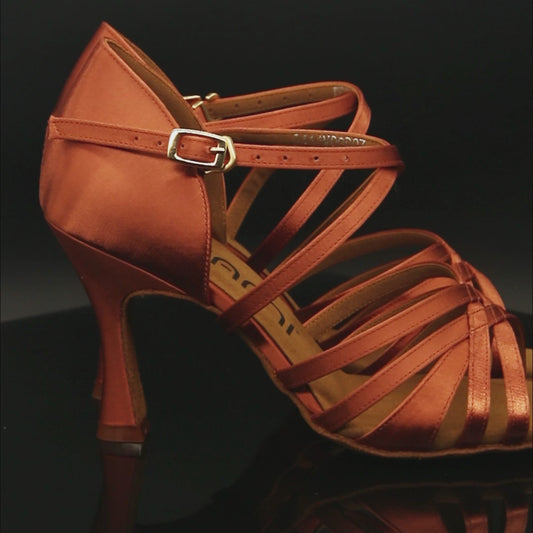
Photo Credit: Dancers Notes
Ballet dancers have their pointe shoes, tap dancers have their tap shoes. For salseros, they have Latin dance shoes. Dance footwear is just as varied as the dance genres that they belong to. Each type is designed to enhance the performance of the dancer by targeting specific parts of the feet.
A good example would be Latin dance shoes. Latin dance is known for its fiery movements and dizzying footwork. A dancer’s body weight rests on the balls of the feet, which explains why the forefoot hurts a lot after dancing for hours. That’s the reason why most Latin dance shoes are designed to ease the pressure off the forefoot. Our own range of Latin dance shoes, for instance, feature strategically-placed cushions to minimize peak impact and alleviate foot pain.
Dance shoes are so crucial to a dancer’s performance because the footwear could literally make or break a performance.
How Dance Shoes Affect Your Dancing
The Shape

Photo Credit: Better Me
The length of your toes and the way that they are set every time you take a step affects your balance. The way your toes move and their length also affects how the weight is distributed on the feet.
If the length of your toes is more equal, the stabler you are on your feet. If a dancer has three or more toes that are relatively the same length, they are less likely to trip and they often have fewer complaints of toe pain.
On the other hand, if a dancer has one toe that's longer than the rest, the feet become less stable. Worse, the longer toe bears the brunt of the impact with every step. This leads to pain and in some cases, injuries.
The same thing can be said about your foot shape, it can affect your balance. Some foot shapes are wide, some are narrow. Dance shoes should have a snug fit so it’s important to get the right shoes for your foot shape. For example, if your toes are wideset, get a pair of dance shoes that are designed for wide feet. If your feet are narrow, opt for a pair of dance shoes that are made for narrow feet.
The Heel

Photo Credit: Ballroom Guide
You might think that you'll do fine dancing in heels since you are used to walking in gravity-defying shoes but you'll find out quickly that this is not the case at all. Dancing and walking are different because they affect different parts of the feet.
When you walk, the foot moves heel to toe, and the distribution of your body weight is spread from the heel to your toes. When you're dancing the salsa, you are using the ball of the foot.
Now imagine dancing the salsa in high heels.
When you're dancing in heels, the bodyweight is shifted on the forefoot. This increases the pressure from the heel to the ball of the foot. With every step you take, the forefoot takes the brunt of the peak impact. Worse, about 75% of your body weight is added to the balls of the feet, which makes each step excruciating. Because of all these, the heel is one of the most important factors that you should consider when shopping around for dance shoes.
You want a pair of dance shoes that’s high enough to elongate the legs and showcase foot articulation but not too high that dancing becomes almost impossible. Heels with a thick base and wide points are more stable compared to heels that taper to a point. That’s the reason why flats and moderately high heels (2.5 to 3 inches) are more comfortable to wear than traditional high heels.
Shoes with a flared heel like those from our Performer series, are perfect for dancers who need flattering dance shoes with just the right heel height. The thicker heel is more stable and the shoes themselves are comfortable to wear. But if you love the look of skinny heels, opt for the stilettos. Dancing in stiletto heels like the Geralyz Sting will take some time to get used to but once you’re accustomed to wearing high heels, you won’t go back to flats ever again.
The Arches

The arch of the foot affects how the bodyweight is distributed on the foot. The arch could range from flat to high. How high the foot arch is could also affect a dancer's performance. Ballet dancers with high arches, for example, are able to dance longer because the high arches distribute the body weight through their pointe shoes. Dancers with flatter arches, on the other hand, may feel more pain because the toes take on the brunt of their body weight. That’s the reason why flat-footed dancers train very hard to improve the line of their feet.
Shoes with stiff insoles, like regular walking shoes, are not ideal for dancing because the arches are not supported. Most dance shoes have a soft, flexible insole to support the arches while minimizing forefoot pain.
We’re all about easing foot pain so our range of dance shoes have thicker cushions to support the arches. Each pair of Yami dance shoes feature microfiber insoles that are soft as a cloud. The material is not only soft and breathable, it also helps distribute the body weight evenly on the foot, easing the pressure on the arches. What's more, the material wicks moisture away from the skin, keeping the feet dry when it counts while also preventing bad odors and fungal growth.
The Ankles

Photo Credit: Be On Move
When you're dancing, your base support constantly shifts. That's why dancers train hard to support their ankles, it's easy to hold your balance when your base is strong. Dance shoes that provide excellent ankle support minimize the risk of injuries by reducing wobbling. Dance shoes with ankle straps, in particular, are perfect for those who are still unsteady on their feet while dancing because the straps provide added ankle support.
Dance shoes with thick, multi-straps like the Melody Chrome are the best choice for dancers who want added support to the ankles. But if you don’t like chunky ankle straps, a great alternative would be the Performer or the Proflex. For all-out ankle support, try the booties! The design is meant to support the ankles while complementing different looks.
The Heel Cup

While most of your body weight rests on the balls of your feet while dancing, the heels should remain supported to prevent wobbling and slipping. Every time you take a step, the peak impact adds intense pressure on your plantar fascia. Dance shoes with solid heel cups help counter overpronation and supination, the pressure that causes foot and back pain while dancing.
The heel cup is the heel-shaped pads that are embedded into the dance shoes to raise the heel, relieve tension, and provide a soft cushion for your heels. Think of heel cups as the shoe’s shock absorber. Depending on how deep the heel cup is, it can align the feet with the ankle, knee, and hips to minimize muscle strain and pain.
All of our dance shoes come with built-in heel cushion pads. The cushion pads provide much-needed heel support and cushion - allowing you to dance 4 times longer in heels. These heel cups also promote stability and proper foot alignment, allowing you to achieve an enviable form as you dance.
Just like any athlete, dancers should always wear the right gears to prevent pain and injuries while training and also during a performance. The right dance shoes could improve a dancer’s balance and form. And it pays to invest in shoes that will last you years like Yami dance shoes.
References
https://www.dancespirit.com/dancer-feet-2624295195.html
https://www.brown.edu/Departments/Joukowsky_Institute/courses/13things/7618.html
https://www.taygra.shoes/blogs/articles/dancing-in-high-heels-might-not-be-the-best-idea
https://www.dancemagazine.com/heel-appeal-2306879446.html
https://www.dancespirit.com/dancer-feet-2624295195.html
https://beyondthebarreusa.com/blogs/fitness-nutrition/top-tips-to-improve-your-arches

